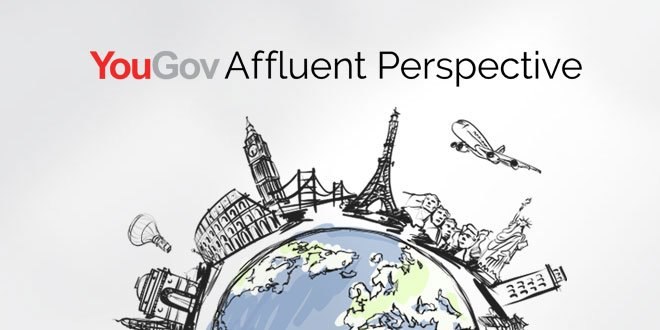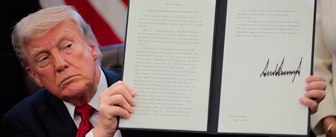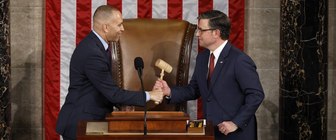The market for luxury is dividing rapidly between affluent high-spending boomers and millennials. Boomers and their Gen X cousins are retreating from brand loyalty as informed advocacy becomes a feature of their shopping behavior. In its inaugural Affluent Perspective Global Study, YouGov is forecasting a .9% reduction in spending in 2016 among all affluent groups, except millennials and America’s 400,000 wealthiest households, whose spending is expected to increase by 8% and 10%, respectively.
YouGov estimates that total discretionary spending by the top 10% of the US economy’s households will be just over $2 trillion.
The 2016 Affluent Perspective Global Study provides an in-depth profile of the world’s most elite consumers based on insights from 5,196 affluent respondents in twelve countries (2,515 in the U.S.). U.S.-based respondents were categorized as the Base Affluent ($150K-$199K in household income or HHI), Middle Affluent ($200K-$349K HHI), and Upper Affluent ($350K+ HHI).
When considered by household income, spending is expected to decrease across the board, by:
- 0.7% among the Base Affluent to $94B;
- 1.4% among the Middle Affluent to $87B; and
- 0.4% among the Upper Affluent to $97B.
Collectively, Boomers and Gen Xers generate the lion’s share of spending across the nine categories ($215B), while Millennials will spend $49B.
One notable exception to the overall decline in spending is among the Wealthy, a subcategory of the Upper Affluent, defined as the approximately 400,000 U.S. households with more than $350K in HHI and assets in excess of $10 million, who are projected to increase luxury spend by 10.2% to $29B.
According to Cara David, managing partner at YouGov, “It’s important not to lose sight of the fact that this year Boomers and Gen X together will spend 4.5x more than the Millennials across the nine categories we monitor. Marketers should be careful not to sacrifice one for the other.”
Category Bright Spots: Travel and Fine Dining
This year, discretionary spending across the nine categories monitored by the Study is expected to reach $277B, down $2B from 2015. Two categories are expected to benefit from an increase in spending:
- Travel (up 10% from 2015 to $119B); and
- Fine dining (up 5% from 2015 to $42B).
Although each age category is expected to increase travel spend by at least nine percent, Millennial spending on travel will increase by 16%, the largest among all age categories. Travel spend is also expected to increase across the three income categories by 8% to 12%.
Spending on apparel, accessories, handbags, items for the home, and fine jewelry and watches will see a cumulative 11% decrease in spending, from $132B in 2015 to $117B.
The Cautious Optimism of the Top 10%
Although we are several years removed from the official end of the Great Recession, a sense of wariness still remains in the psyche of affluent families in the U.S. This caution does not necessarily reflect concerns about the divide between the 99% and the one percent, as 39% of all respondents expressed that they were either extremely or very concerned about the wealth gap. Rather, America’s affluent families are motivated by a need to protect their own personal economy. While 38% of all Study respondents – including 56% of the Wealthy – believe that the U.S. is heading towards another recession and only 29% of the U.S. affluent are bullish on the U.S. economy, 57% of the affluent in the U.S. are extremely or very confident of their personal economy – including 83% of the wealthy.
“It is worth noting that a major consequence of the Great Recession among the nation’s affluent is that they are prepared to make immediate adjustments,” said Dr. Jim Taylor, senior advisor to the study. “In some cases, the nation’s affluent are even willing to eliminate certain luxuries from their lives altogether, should their household experience a financial setback.”
Interestingly, two of the most vulnerable purchasing categories should the U.S. face an economic downturn are the two categories that are projected to benefit from an increase in spending over the next year – leisure travel and dining out.
When it Comes to Luxury, Youth is Being Served
Another interesting phenomena is the revelation that people are first introduced to luxury at an earlier age – especially across generations. According to the Study, 90% of affluent Millennials have had their initial introduction to luxury by the age of 37. Meanwhile 72% of Gen Xers, 61% of Boomers, and only 55% of Matures had their first experiences by this age.
Furthermore, the initial introduction into luxury among Millennials is a result of luxury being gifted to them, with 58% of younger millennials (age 18-29) and 37% of older millennials (age 30-37) claiming that their first luxury experience was paid for by someone else. By contrast, more than 60% of Gen X, Boomers, and Matures claimed that they themselves paid for their first luxury item or experience. The early adoption among Millennials into the luxury lifestyle is the result of their parents, the Boomers, serving as a catalyst, as 61% of young Millennials who received their first luxury item or experience as a gift received it from their parents.
“Additionally, millennials cite price as the number one indicator of luxury,” said Cara David. “For luxury brands and luxury brand managers, this means that there is a need to help them evolve from a relatively immature consumer to one that will come to appreciate the true value of luxury including the artistry and craftsmanship of the product or experience itself.”
About the Study Methodology
The 2016 YouGov Affluent Perspective Global Study provides an in-depth profile of the world’s most elite consumers, gleaning insights from 5.196 affluent respondents in 12 countries (2,515 in the US). In the US, the top 10% is defined as households that earn more than $150,000 in discretionary income in the year they are surveyed. For the purpose of the Study, the sample is subdivided into three independent random samples: Base Affluent, Middle Affluent, and the Upper Affluent, assuring representation at each level.
About YouGov
YouGov is a leading international full-service research and consulting company and a pioneer in the use of technology to collect higher-quality, in-depth data for the world's leading businesses and institutions so that they can better serve the people that sustain them. With offices throughout the US, UK, Europe, the Middle East and Asia, YouGov leverages its online sampling, research expertise and consulting experience to provide clients with sophisticated market strategy, market analytics, and survey and forecasting services.
# # #










